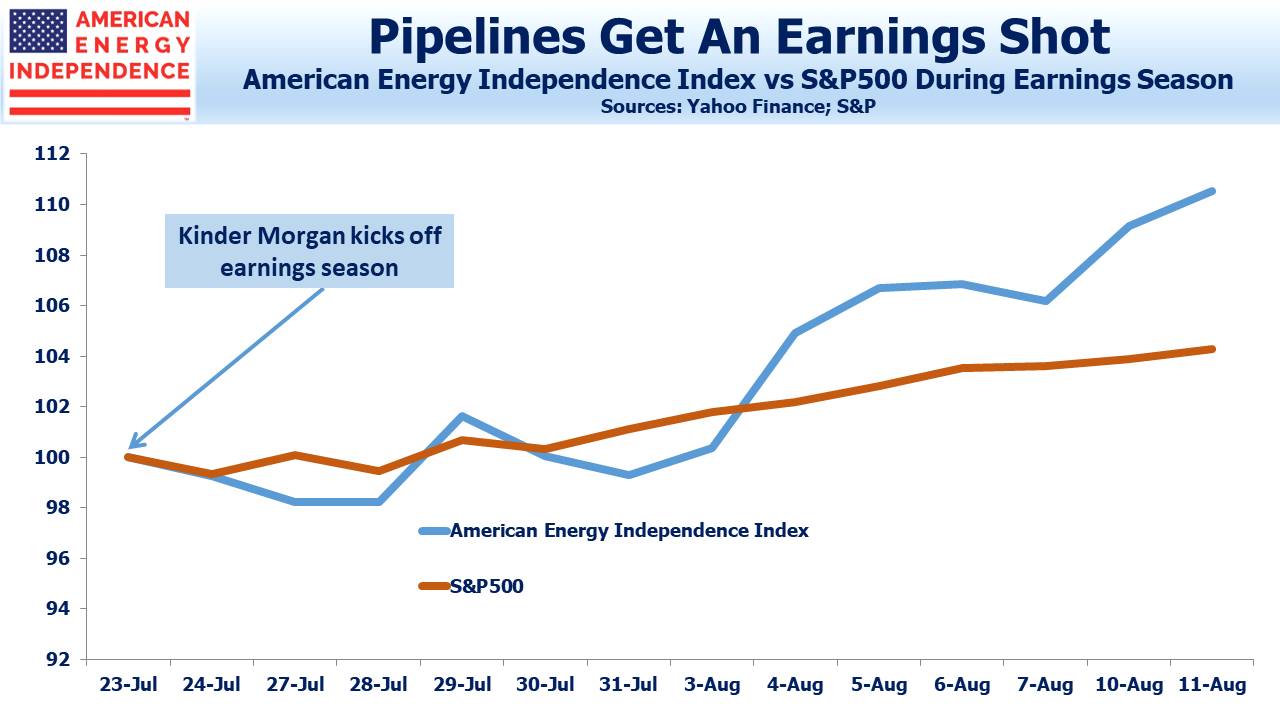Pipeline Earnings Provide A Boost
Investors often ask, what will it take to get pipeline stocks moving upwards? Attractive valuations and the prospect of higher cashflows are compelling, but when will investors start acting?
They may already being doing so. Kinder Morgan kicked off earnings after the close on July 23rd. Since then, results for the sector have generally come in as expected, with more positive surprises than negative. The encouraging free cash flow outlook remains intact (see Pipeline Cash Flows Will Still Double This Year). The most positive among the big companies was Williams Companies (WMB), whose earnings scarcely showed any impact of the pandemic (see Williams Has Covid Immunity). Their gathering and processing business held up better than volumes across the country, and WMB took another $100MM off their 2020 growth capex which further cheered investors. WMB was up 8% following the announcement.
The two big Canadians, Enbridge (ENB) and TC Energy (TRP) were both resilient. ENB even added $100MM to their growth capex plans – they’re probably the only company that could do so without seeing their stock sell off. TRP has one of the bigger capex budgets, mostly driven by the perennially delayed Keystone XL. Joe Biden has committed to withhold the required Federal approval of this cross-border project, reflecting a leftward shift in his platform. If he wins the election, Canadian oil producers will suffer but investors in TRP will likely benefit from higher free cash flow without the Keystone spending.
Cheniere Energy (CEI) reported $405MM of cargo cancellation revenues. Cheniere has always maintained that their 100% investment grade customer base and very long term contracts insulated the company from fluctuating volumes. Falling demand for shipments of Liquified Natural Gas (LNG) caused some weakness in CEI earlier in the quarter. The $405MM represents some tangible evidence of the security of the contracts. Typically, when a buyer cancels a contract CEI takes ownership of the LNG shipment and is free to find a new buyer.
Energy Transfer (ET) remains one of the cheapest big pipeline companies – their eye-popping 17% yield is in part because of CEO Kelcy Warren’s opportunistic ethical lapses (see Energy Transfer’s Weak Governance Costs Them). Questions remain around their elevated leverage, which is still above 5X. Some analysts would like to see them cut their distribution so as to delever faster. The company believes they can rely on growing EBITDA, although CFO Tom Long did say, “…the distributions are a topic when we discuss how to get the leverage down.” So that 17% yield isn’t secure.
Oneok (OKE) saw weaker than expected gathering and processing results, and they revised full year EBITA guidance to the low end of the range so they see continuing softness.
We thought Plains All American (PAGP), which is all crude oil, should have done better in their Supply and Logistics (S&L) segment. The dislocation in April was manifested by the negative price for front month of futures. This should have been a perfect environment to own storage assets in multiple locations and the pipes to connect them. Disappointingly, PAGP’s S&L segment adjusted EBITDA came in at only $3MM, and is running at $144MM for the first half of the year. During 1H19 they did $478MM. Management has done a good job at lowering analyst expectations for this business. Enterprise Products Partners’ (EPD) Marketing segment turned storae and contango opportunities into $185MM in 2Q20. PAGP should be aiming higher.
Overall, midstream energy infrastructure earnings were good, and with dividend yields still above 8% it is poised to move higher.
We are invested in the names mentioned above and all the components of the American Energy Independence Index via the ETF that seeks to track its performance.
